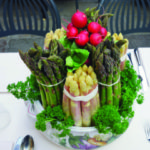Fonts are also important from a practical standpoint: They convey information. For meeting and conference signage, typeface should be as clear and carefully chosen as diction. Tim Jung, graphic designer at HMR Designs in Chicago, shares some guidelines:
Complementary cases
For signs with more content than just a name and event title, choose at least two distinct, complementary fonts. Tim recommends mixing serifs with sans serifs, so it’s clear that the dissimilarity is intended. Differentiation allows for emphasis and breaks up the text.
Distance learning
The most important information on any sign must be legible from afar. Fonts that are less flowery and ornamental withstand the test of distance, and can better accommodate other contrast-inducing effects like emboldening and shadowing. Remember that high contrast is essential to give your signage the needed pop.
Proper attire required Knowing the intended mood and audience of your event should affect your lettering choices. A legal seminar, confectioners conference, and nightclub symposium all require different garb, type-wise. “Fonts are just another way to tie elements of your style together,” Tim noted. “And remember: You can have fun with them, regardless of the formality of your agenda.”
Heidi Lombardo is a brand and media producer for Heffernan Morgan Ronsley, a Chicago-based event design and production company.



